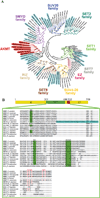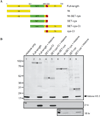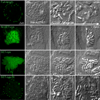Identification of functional modules of AKMT, a novel lysine methyltransferase regulating the motility of Toxoplasma gondii
- PMID: 23685344
- PMCID: PMC3740173
- DOI: 10.1016/j.molbiopara.2013.05.004
Identification of functional modules of AKMT, a novel lysine methyltransferase regulating the motility of Toxoplasma gondii
Abstract
The intracellular parasite Toxoplasma gondii is a leading cause of congenital neurological defects. To cause disease, it must reiterate its lytic cycle through host cell invasion, replication, and parasite egress. This requires the parasite to sense changes in its environment and switch between the non-motile (for replication) and motile (for invasion and egress) states appropriately. Recently, we discovered a previously unknown mechanism of motility regulation in T. gondii, mediated by a lysine methyltransferase, AKMT (for Apical complex lysine (K) methyltransferase). When AKMT is absent, activation of motility is inhibited, which compromises parasite invasion and egress, and thus severely impairs the lytic cycle. Although the methyltransferase activity of AKMT has been established, the phylogenetic relationship of AKMT with other better studied lysine methyltransferases (KMTs) was not known. Also unknown was the functional relationships between different domains of AKMT. In this work we carried out phylogenetic analyses, which show that AKMT orthologs form a new subfamily of KMTs. We systematically generated truncation mutants of AKMT, and discovered that the predicted enzymatic domain alone is a very poor enzyme and cannot complement the function of AKMT in vivo. Interestingly, the N- and C-terminal domains of the AKMT have drastically different impacts on its enzyme activity, localization as well as in vivo function. Our results thus reveal that AKMT is an unusual, parasite-specific enzyme and identified regions and interactions within this novel lysine methyltransferase that can be used as drug targets.
Copyright © 2013 Elsevier B.V. All rights reserved.
Figures






Similar articles
-
The motility of a human parasite, Toxoplasma gondii, is regulated by a novel lysine methyltransferase.PLoS Pathog. 2011 Sep;7(9):e1002201. doi: 10.1371/journal.ppat.1002201. Epub 2011 Sep 1. PLoS Pathog. 2011. PMID: 21909263 Free PMC article.
-
Structure of a Novel Dimeric SET Domain Methyltransferase that Regulates Cell Motility.J Mol Biol. 2018 Oct 19;430(21):4209-4229. doi: 10.1016/j.jmb.2018.08.017. Epub 2018 Aug 24. J Mol Biol. 2018. PMID: 30148980 Free PMC article.
-
Three F-actin assembly centers regulate organelle inheritance, cell-cell communication and motility in Toxoplasma gondii.Elife. 2019 Feb 12;8:e42669. doi: 10.7554/eLife.42669. Elife. 2019. PMID: 30753127 Free PMC article.
-
Calcium signaling and the lytic cycle of the Apicomplexan parasite Toxoplasma gondii.Biochim Biophys Acta Mol Cell Res. 2018 Nov;1865(11 Pt B):1846-1856. doi: 10.1016/j.bbamcr.2018.08.004. Epub 2018 Aug 10. Biochim Biophys Acta Mol Cell Res. 2018. PMID: 30992126 Free PMC article. Review.
-
Is Toxoplasma egress the first step in invasion?Trends Parasitol. 2002 Jun;18(6):251-5. doi: 10.1016/s1471-4922(02)02240-7. Trends Parasitol. 2002. PMID: 12036737 Review.
Cited by
-
Comparative genome-wide identification and characterization of SET domain-containing and JmjC domain-containing proteins in piroplasms.BMC Genomics. 2024 Aug 26;25(1):804. doi: 10.1186/s12864-024-10731-2. BMC Genomics. 2024. PMID: 39187768 Free PMC article.
-
The Conoid Associated Motor MyoH Is Indispensable for Toxoplasma gondii Entry and Exit from Host Cells.PLoS Pathog. 2016 Jan 13;12(1):e1005388. doi: 10.1371/journal.ppat.1005388. eCollection 2016 Jan. PLoS Pathog. 2016. PMID: 26760042 Free PMC article.
-
Lysine Methyltransferase EhPKMT2 Is Involved in the In Vitro Virulence of Entamoeba histolytica.Pathogens. 2023 Mar 17;12(3):474. doi: 10.3390/pathogens12030474. Pathogens. 2023. PMID: 36986396 Free PMC article.
-
Putative SET-domain methyltransferases in Cryptosporidium parvum and histone methylation during infection.Virulence. 2022 Dec;13(1):1632-1650. doi: 10.1080/21505594.2022.2123363. Virulence. 2022. PMID: 36097362 Free PMC article.
-
Alveolar proteins stabilize cortical microtubules in Toxoplasma gondii.Nat Commun. 2019 Jan 23;10(1):401. doi: 10.1038/s41467-019-08318-7. Nat Commun. 2019. PMID: 30674885 Free PMC article.
References
-
- Levine ND. Progress in taxonomy of the Apicomplexan protozoa. J Protozool. 1988;35:518–520. - PubMed
-
- Holliman RE. Toxoplasmosis and the acquired immune deficiency syndrome. J Infect. 1988;16:121–128. - PubMed
-
- Fleming AF. Opportunistic infections in AIDS in developed and developing countries. Trans R Soc Trop Med Hyg. 1990;84(Suppl 1):1–6. - PubMed
-
- Belanger F, Derouin F, Grangeot-Keros L, Meyer L. Incidence and risk factors of toxoplasmosis in a cohort of human immunodeficiency virus-infected patients: 1988–1995. HEMOCO and SEROCO Study Groups. Clin Infect Dis. 1999;28:575–581. - PubMed
-
- Vastagh I, Jelencsik I, Barsi P, Balint K, Szlavik J, Szirmai I. Single cerebral Toxoplasma abscess: first manifestation of HIV infection. Eur J Neurol. 1999;6:725–726. - PubMed
Publication types
MeSH terms
Substances
Grants and funding
LinkOut - more resources
Full Text Sources
Other Literature Sources

